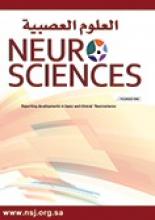Abstract
OBJECTIVE: To assess the mutational and clinical spectrum of spatacsin associated with autosomal recessive hereditary spastic paraplegia (ARHSP) with thin corpus callosum (TCC).
METHODS: A retrospective study was carried out at King Faisal Specialist Hospital and Research Centre, Riyadh, Saudi Arabia from February 2008 until March 2011. Four unrelated Saudi Arabian families with ARHSP-TCC were studied, totaling 13 affected individuals. Clinical presentations included gait disturbance at variable ages (2-18 years), spastic paraplegia with mild to moderate cognitive impairment and evidence of peripheral neuropathy in 2 families. Brain MRI showed TCC accompanied by periventricular white matter changes and cortical atrophy.
RESULTS: A genome wide scan demonstrated linkage to the SPG11 locus. Sequencing revealed 4 mutations. The first is an insertion/deletion (indel) consisting of a 3 base pair (bp) deletion and 23 bp insertion (L1268L fsX), the second is a one bp deletion (S1923R fsX), and the third and the fourth are nonsense mutations (Q341X and R651X). All mutations predict premature truncation of the spatacsin protein.
CONCLUSION: We report 2 novel mutations in this gene, including an indel considerably larger than any other identified to date. The identification of these mutations further confirms the causative link between SPG11 and ARHSP-TCC in these families.
- Copyright: © Neurosciences
Neurosciences is an Open Access journal and articles published are distributed under the terms of the Creative Commons Attribution-NonCommercial License (CC BY-NC). Readers may copy, distribute, and display the work for non-commercial purposes with the proper citation of the original work.






